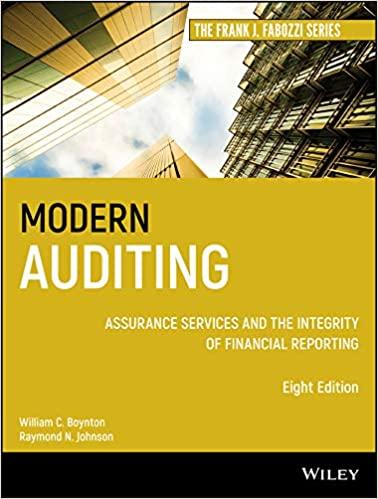Question
16. Which of the following is the least useful in reducing the risk of unauthorised distribution of financial data in General Ledger and Financial Reporting
16.
Which of the following is the least useful in reducing the risk of unauthorised distribution of financial data in General Ledger and Financial Reporting cycle?
a.
Electronic reports should have limited print/redistribute functionality
b.
Reports should not be printed using printers in the common/public area
c.
Electronic reports should be stored in a secure location, subject to tight access controls.
d.
Communicating verbally with staff not to read and distribute unauthorised management reports
17.
The AR clerk prepares an invoice based on the updated pricing in the inventory master file, but this is different from the original quote accepted by the customer. Which control will not prevent or detect this weakness?
a.
Independent check of invoice against the sale order and the accepted quote before approval
b.
Reconciling sales invoices in the billing department to the total debits of accounts receivable subsidiary ledgers.
c.
Automatic matching of invoice against sales order and quote and notification of any discrepancies to AR and Sales department.
18.
Computerised AISs help to: i. Generate information from raw data ii. Enable audit trails iii. Speed up information processing iv. Detect errors in data entry
a.
All are correct
b.
All except iv
c.
All except ii
d.
All except i
19.
A company is considering adopting a new procurement system. The company is quickly expanding to different locations, and acquiring and merging different incompatible businesses, including real estate, health care, and consulting. Its IT department is well-equipped and understands the diverse business needs of different departments and functions. Which of the following is most likely to be a suitable strategy to acquire the new system?
a.
Lease the application from an external vendor
b.
Develop the system in-house
c.
Customize a prewritten system
d.
Outsource the development to an external vendor
20.
What methods are used to conduct a new system's cost-benefit analysis? i. Net prevent value; ii. Return on investment; iii. Breakeven analysis; iv. User feedback and recommendations
a.
All are correct
b.
i, ii and iii
c.
i, ii and iv
d.
ii, iii and iv
Step by Step Solution
There are 3 Steps involved in it
Step: 1

Get Instant Access to Expert-Tailored Solutions
See step-by-step solutions with expert insights and AI powered tools for academic success
Step: 2

Step: 3

Ace Your Homework with AI
Get the answers you need in no time with our AI-driven, step-by-step assistance
Get Started


